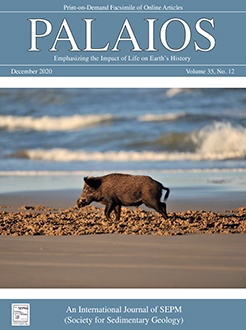Free-living forms of crustose coralline algae (rhodoliths) accumulate on shallow-water marine shelves in many regions worldwide. They form their own benthic habitats termed ‘rhodolith beds’ and their deposits are well preserved in the rock record. Characteristics of rhodolith deposits can be used to interpret ancient water depths, light levels, and water energies. Accurate paleoceanographic interpretations rely on large-scale, detailed studies of living rhodolith beds, but these studies are scarce. Spencer Gulf in South Australia has the largest living rhodolith beds in southeastern Australia (∼ 3,000 km2). Documentation of these rhodolith deposits includes facies analysis, coralline algal taxonomy, characterization of growth forms and morphometrics, and integration with oceanographic data. Extensive oceanographic data and hydrodynamic modeling enable comparisons between rhodolith morphologies and bottom water energies with unprecedented accuracy. Rhodolith deposits in the gulf are intermixed with carbonate sands and muds under diverse hydrodynamic conditions, with current speeds up to 1.04 m s–1. At least five coralline algal genera construct rhodoliths in Spencer Gulf. Growth forms include fruticose, lumpy, and warty. Rhodolith morphologies imply that water energy is not the only thing affecting rhodolith movement and growth; rhodoliths can also be shifted by fish and invertebrates. Linear regression models in this study evaluate relationships between rhodolith morphometrics (mean diameter, sphericity, and branch density) and maximum bottom water speeds in Spencer Gulf and their results support the idea that water energy is not a major control on rhodolith morphology under these water energy conditions. Previous studies have revealed that the relationship between rhodolith morphologies and water energy levels is complicated and many authors have cautioned to not rely solely on rhodolith morphologies to interpret paleoceanographic conditions. Results of this study demonstrate that accurate paleoceanographic interpretations cannot be made based on rhodolith morphologies alone, but should also include sedimentology, coralline taxonomy, and associated biota.
How to translate text using browser tools
12 January 2021
REEVALUATION OF THE INFERRED RELATIONSHIP BETWEEN LIVING RHODOLITH MORPHOLOGIES, THEIR MOVEMENT, AND WATER ENERGY: IMPLICATIONS FOR INTERPRETING PALEOCEANOGRAPHIC CONDITIONS
Laura G. O'Connell,
Noel P. James,
Adela S. Harvey,
John Luick,
Yvonne Bone,
Scoresby A. Shepherd
ACCESS THE FULL ARTICLE
It is not available for individual sale.
This article is only available to subscribers.
It is not available for individual sale.
It is not available for individual sale.
<
Previous Article
|

PALAIOS
Vol. 35 • No. 12
December 2020
Vol. 35 • No. 12
December 2020




